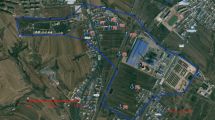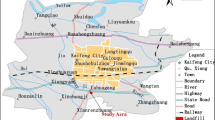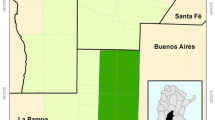Abstract
More than 30 organic contaminants were detected in shallow groundwaters at Wuhan, the largest city in central China. Seriously contaminated groundwaters were from densely populated, industrial and commercial areas. Abnormal concentrations were found in groundwater from Hankou, downtown Wuhan: trimethylbenzene up to 29 μg/L, tetramethylbenzene up to 866 μg/L, and trichloroethene up to 9.5 μg/L. Benzene, Toluene, Ethylene and Xylene (BTEX) contamination of groundwater is serious and widespread at Wuhan, ranging between 0.14 and 25.0 μg/L. Considering the hydrogeological conditions of most Chinese cities, DRAMIC, a modified version of the widely used DRASTIC model, was proposed by the authors for assessing vulnerability of groundwater to contamination. The factors D, R, A and I in DRAMIC model are the same as in DRASTIC. The factor topography is ignored. The factor soil media is substituted by a new factor aquifer thickness (M) and the factor hydraulic conductivity of the aquifer by a new factor impact of contaminant (C). The equation for determining the DRAMIC Index is: DRAMIC = 5D R + 3R R + 4A R + 2M R + 5I R + 1C R. The calculated DRAMIC Index can be used to identify areas that are more likely to be susceptible to groundwater contamination relative to each other. The higher the DRAMIC Index is, the greater the groundwater pollution potential. Applying DRAMIC, a GIS-based vulnerability map for Wuhan city was prepared. Interestingly, places such as downtown Hankou, where enhanced concentrations of BTEX have been detected, correspond quite well with those with higher DRAMIC ratings.

Similar content being viewed by others
References
Aller L, Bennet T, Lehr JH, Petty RJ (1985) DRASTIC: standardized system for evaluating ground water pollution potential using hydrogeologic settings. Office of Research Development, US EPA, Ada, Oklahoma
Doerfliger N, Jeannin PY, Zwahlen F (1999) Water vulnerability assessment in karst environments: a new method of defining protection areas using a multi-attribute approach and GIS tools (EPIK method). Environ Geol 39:165–176
Evans BM, Myers ML (1999) A GIS-based approach to evaluating regional groundwater pollution potential with DRASTIC. J Soil Water Conserv 3:242–245
Foster SSD (1987) Fundamental concepts in aquifer vulnerability, pollution risking and protection strategy. In: van Duijvanbooden W, van Waegeningh HG (eds), Vulnerability of soil land and groundwater to pollution, proceedings and information NO.38 of the international conference held in the Netherlands, TNO Committee on Hydrological Research
Gogu RC, Dassargues A (2000) Current trends and future challenges in groundwater vulnerability assessment using overlay and index methods. Environ Geol 39:549–559
Hrkal Z (2001) Vulnerability of groundwater to acid deposition, Jizerske Mountains, northern Czech Republic: construction and reliability of a GIS-based vulnerability map. Hydrogeol J 9:348–357
Lake IR, Lovett AA, Hiscock KM (2003) Evaluating factors influencing groundwater vulnerability to nitrate pollution: developing the potential of GIS. J Environ Manage 68:315–328
Loague K, Bernknopf RL, Green RE, Giambelluca TW (1996) Uncertainty of groundwater assessments for agricultural regions in Hawaii: Review. J Environ Qual 25:475–490
Margat J (1968) Ground water vulnerability to contamination (in French). Bases de al cartographie, (Doc.) BRGM, 68 SGC 198 HYD, Orleans, France
National Research Council (1993) Ground water vulnerability assessment: contamination potential under conditions of uncertainty. National Academy Press, Washington, DC
Rao PSC, Alley WM (1993) Pesticides. In: Alley WM (ed) Regional groundwater quality. Van Nostrand Reinhold, New York, pp 345–382
Ray IA, Odell PW (1993) DIVERSITY: a new method for evaluating sensitivity of groundwater to contamination. Environ Geol 22:344–352
Rupert MG (2001) Calibration of the DRASTIC ground water vulnerability mapping method. Ground Water 39(4):625–630
Van Stempvoort DL, Evert LW (1993) Aquifer vulnerability index: a GIS compatible method for groundwater vulnerability mapping. Can Water Res J 18:25–37
Wuhan EPB (2001) Strategy for poverty reduction through urban environmental improvement: a case study at Wuhan. ADB TA project.report
Acknowledgments
The research work was financially supported by grants from DFG and DAAD to B Merkel and from NSFC (Grant No.40425001) to Y. Wang. An anonymous reviewer and Dr Andrzej Witkowski are appreciated for helping to improve the manuscript.
Author information
Authors and Affiliations
Corresponding author
Rights and permissions
About this article
Cite this article
Wang, Y., Merkel, B.J., Li, Y. et al. Vulnerability of groundwater in Quaternary aquifers to organic contaminants: a case study in Wuhan City, China. Environ Geol 53, 479–484 (2007). https://doi.org/10.1007/s00254-007-0669-y
Received:
Accepted:
Published:
Issue Date:
DOI: https://doi.org/10.1007/s00254-007-0669-y




